Although the coronavirus pandemic is expected to reduce global IT spending by 7.3% through the back half of 2020 compared to 2019, one segment is apparently immune to the virus’s effects: infrastructure-as-a-service.
Spending on cloud is expected to grow unchecked at a rate of 13.4%, reaching $50.4 billion this year and $64.3 billion in 2021, driven by the need to improve efficiency and resiliency while reducing costs and maximizing ROI across all industries.
It’s relatively straightforward to build natively on cloud, but existing on-premise applications must be rewritten to take full advantage of the cloud environment and maximize ROI. At a time when many organizations are already running at maximum speed and capacity, finding the additional resources to do a ground-up rewrite is a non-starter.
There is another option, however, that can deliver many of the benefits of cloud migration without the resource commitment of a full rewrite: application modernization with IBM Cloud Pak.
Advantages of modernizing with IBM Cloud Pak?
Modernized applications break down large single on-premise applications into much smaller, nimbler containerized microservices hosted in a variety of cloud configurations. IBM Cloud Paks are enterprise-ready, containerized software solutions that enable an open, faster, and more secure way to move core business applications to any cloud based on Red Hat’s OpenShift containerization and orchestration platform.
Organizations that deploy applications with Red Hat OpenShift on AWS, for example, are realizing the following benefits:
- 5 months to 100% ROI
- 661% five-year ROI
- 54% reduction in infrastructure costs
- 24% higher developer productivity
- >200% more new applications and features
- 49% faster development of new apps
- 56% faster development of new features

Key considerations before deploying IBM Cloud Paks
The development teams at Persistent Systems have been modernizing and deploying legacy IBM applications on the cloud for the last several years, and our teams have identified four areas for prospective users to consider before proceeding with an IBM Cloud Pak deployment:
1. Functional Considerations
Begin by documenting your application’s workload and use case considerations in advance, including:
- The types of workloads required, identifying general computing needs as well as CPU intensive, memory-intensive, and storage-intensive tasks.
- The load patterns of the workloads, whether they’re static, consistent of periodic spikes, regular batch, unpredictable loads, or some combination.
- What cloud architecture you need. Will the application require the control and security benefits of a single tenancy environment or is multi-tenancy an option to drive lower costs and better scalability?
- How many Cloud Paks you expect to deploy on the same cluster, since some applications may require more than one depending on the application’s footprint.
- What your anticipated growth trajectory will be for the application.
- Your integration requirements, cataloging the other applications in your ecosystem that will need to continue to communicate with this application after it’s migrated.
2. Non-functional Considerations
In addition, your application will have a variety of considerations that might constrain the application’s performance if they’re not accounted for prior to migration. These include:
- The application’s availability and resiliency requirements. How mission-critical is the application to your business, and how much uptime is required?
- What the application’s performance requirements are, including expected throughput, response time, max error rate, and more.
- How quickly the application must scale to meet demand, and what the expected peak load, based on historical data and projected usage.
- How much network bandwidth your application consumes to meet all performance goals.
- Detailing the specific security requirements of the application.
- The compliance and obligatory needs for the application, including industry and geographic compliance and any other professional commitments, like service level agreements (SLAs), the application must uphold.
3. Operational Considerations
Beyond the needs of the application itself, you’ll want to assess a number of operational considerations prior to an IBM Cloud Pak deployment, including:
- The readiness of the operational team. Do you have the required skill and scale needed to support the modernized application once it’s deployed to the cloud?
- The capacity plan for the application’s on-prem compute, storage, and network needs.
- The operational efficiency and SLA commitments to the organization, including response times, new feature and function development, patches, and more.
4. IBM Cloud Pak-specific Considerations
Lastly, you’ll want to take into account a few considerations specific to IBM Cloud Pak, including:
- Any deployment prerequisites and constraints that might impact the migration and modernization outcomes.
- Any specific capacity and configuration requirements that might need to be taken into account prior to deployment.
Accelerate your IBM Cloud Pak deployment with Persistent Systems
IBM Cloud Paks can help organizations of all sizes accelerate their digital transformation and deploy applications quickly to transform their business and build new capabilities, but they do require technical and business resource commitments to deploy quickly and successfully.
Persistent Systems has more than 2,000 containerization experts on staff around the globe, ready to help your organization speed the deployment and configuration of IBM Cloud Paks to accelerate your journey to application modernization and hybrid cloud by:
- Configuring container platforms and operational services
- Installing Cloud Paks
- Preparing environments
- Developing a pilot solution
- Moving the workload into production
We manage your deployment complexity with the right combination of containerization, cloud platform management, and IBM solution skills, along with a flexible global delivery footprint to deliver the right support in the right geographies, anywhere in the world.
Interested in learning more about Cloud Pak deployment with Persistent Systems? Click here!
Find more content about
Application Modernization (3) IBM Cloud Pak (1) Infrastructure As A Service (1)






